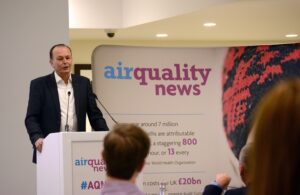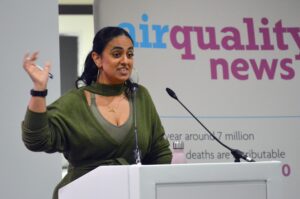Report: The National Air Quality Conference 2023
On 8th November, we held our 2023 National Air Quality Conference at Lord’s Cricket Ground in London and there was consensus among the AQN team, as we took the train back up North, that it was a very successful event indeed.
Lord’s is a superb venue for such an event. Aside from the quality of the food – ‘I’ve never had duck at an event like this before’ confessed Cllr Clyde Loakes at the start of his presentation – the venue is modern, bright and perfectly laid-out. Of course, you would expect high standards at the home of the Marlybone Cricket Club, and for the fourth time, they did not let us down.
Cllr Beverley Nielsen again hosted the event seamlessly and following her opening remarks, her first task was to introduce Zack Polanski, Deputy Leader of the Green Party and an elected member of the London Assembly.

Zack discussed his relationship with The Mayor of London and the political chivvying – for want of a better word – he employed to see that air quality schemes in which he deeply believed, were seen through to fruition. No sooner was the ULEZ expansion underway and Zack was using Mayor’s Question Time to push for a Zero Emission Zone.
Zack discussed the controversial Silvertown Tunnel project which he sees as an example of social injustice, making the point that we cant have environmental justice without social justice. He also covered road user charges, of which he understood the mayor to be fully supportive, until the gathering storm made him reign back on the concept.
On top of everything else, Zack has recently published a report on retrofitting which concluded that at the current rate we’ll finish retrofitting the necessary buildings by some point in the next century.

Quentin Willson was an ideal speaker to follow Zack, as his vision for the future is aligned with Zack’s belief in zero emission zones. Of all the UK’s best-known motoring faces, Quentin is the one who has most emphatically made the switch away from the combustion engine.
His Damascene moment – a late 90s review of a General Motors EV1 in California – is still available to watch. The first EV he bought – much to the shame of his children – had a range of 50 miles or ’30 with the heater on’. Quentin addressed the need to think carefully about how we engage people, to persuade them away from polluting cars. He cites a lady on social media who promised that she would never drive an EV and what’s more, her next car would be the most polluting diesel she could find. ‘Why’ he asked, ‘do people think like this?’
He believes that anti-EV sentiment does not originate from consumers but from darker forces than that. One tabloid, he tells us, managed to published anti-EV stories for 196 consecutive days – a tabloid financed by a Saudi sovereign fund. ULEZ, he believes was the right thing to do, but it has done the cause no good at all. We can’t hector people. We need to communicate better and engage people. ‘Are we winning? I’m not sure, we’re at a difficult place.’
After the first break of the day – a Lord’s pastry and a chance for the delegates to introduce themselves to each other and chat with our exhibitors – we returned for our traditional panel session. Beverley introduced the five members and asked them to talk about their current work, after which questions were taken from the floor.

Laura Fatah, Head of Policy and Advocacy at Global Acton Plan talked about Clean Air Night which will be launched in January next year as a complimentary event to their well-established Clean Air Day. She also told us about The Clean Air Hospital Framework, a free resource, developed by GAP alongside Great Ormond Street Hospital, that is being used by hospitals across the UK to clean up their air. Laura is also leading a new partnership with Health Equals where she has developed a Clean Air Advisory Group.
Agnes Agyepong is the founder of Global Black Maternal Health and was behind the Black Child Clean Air report which was published on Clean Air Day this year. She described her accidental journey into the area of air quality – ‘I’m the least likely clean air advocate you can imagine. I used to think air quality was a middle class issue. The average person was not talking abut PM2.5.’ But asthmatic episodes suffered by her daughter alarmed her enough to educate herself on the problems of air pollution, examine the problem in more depth and begin campaigning to make others aware of it. There is a known link between still births and air pollution and, as air pollution is more prevalent in deprived areas, these are the mums her campaigns are trying to reach.
John Galsworthy is Director of Climate Change and Transport at Hammersmith & Fulham Council and he explained how the borough are trying to tackle the problems of traffic in real terms and in terms of communicating the that to residents. The borough has a creditable record of air quality monitoring and are now using technology to create car free road space for certain periods of time, as well as AI to track movement, to inform future policy.
Louise Thomas came into the air quality world through her daughter’s primary school. Her original concerns were over road safety, which grew into concern about the air around the school. She learned about how young children are worst affected by traffic pollution and worked with Lambeth on installing the first school street. She joined the Breathe network because she was enthused by their well calibrated monitors which provided reliable data. ‘I’d never trusted [official] data before because my hand-held monitor told a different story.’ Taking her interest in air quality further, Louise, and her partner Sacha, have set up the excellent AirAware blog. She has now left her job at the Foreign Office and has joined the Zinc venture builder which supports start-up companies moving into social environmental work.
Our final panelist was Nick Ruxton-Boyle from Marston Holdings who, through their subsidiary Vortex, were our event sponsors. Introducing himself as a transport professional rather than an air quality expert, Nick focused on transport as it is a large part of the problem. ‘I did John’s job ten years ago’ he said, alluding the man two seats away, ‘and we didn’t have the technology to do the job, but we do now’. Nick talked about how transport appraisal used to considered nothing more than ‘how can we get there quicker’ whereas it has moved on to consider matters of health. Indicative monitors, Nick explained, have a huge role to play in educating people and – if the data is shared – helping improve DEFRA decisions and councils’ understanding of their problems.

Cllr Clyde Loakes, Deputy Leader, Waltham Forest Council was our next speaker. Other hats worn by Clyde include Cabinet Member for Climate and Air Quality, while he also leads on all environmental, climate and transport policies, as well as highways and parking management.
Waltham Forest was one of three boroughs chosen to trial the Mini Holland scheme in 2013/14 and received £27m to do it. Since then the borough has maintained its momentum to the extent that last year it saw the second highest reduction in car ownership in London.
Controlled parking zones helped eliminate the problem of commuters from Essex parking up and getting the tube into London. There are 22 schools streets which are ‘ruthlessly enforced’. The borough occasionally closes a road to have a ‘Car Free Celebration’ and by next year there will be around 1,200 cycle hangers – each one sited in a space that was previously used to park a car.
EVs are not seen as the answer but ‘they are better’. That said, the council will only countenance public charging – they don’t want residents digging up the pavement to run a cable through it. As result of all these measures, Clyde says the borough is benefitting from people arriving from such areas as Islington and Camden to spend some time and, of course, money.

Angela Halliwell and Stephen Inch from National Highways presented jointly. Angela as the head of the newly formed Central Carbon Team, and Stephen as the Air Quality Programme Lead. Angela explained how National Highways have brought air quality and carbon together and will be increasingly collaborative going forward, This seems very likely to include the sharing of historic data. In a further effort to be more engaging, National Highways now have a dedicated air quality email address through which people can contact them.
Stephen spoke of the new role the organisation now has as a ‘relevant public authority,’ meaning Local Authorities can approach them to be an air quality partner. Again, Stephen touched on data sharing – there are hundreds of diffusion tubes across the network and National Highways will look to share not only this data but their research too. And not just with air quality professionals, but for people in the ‘real world’ who have to live next to A-roads.

Gary Fuller spoke at our first conference and we were delighted to have him back. As one of the country’s three air quality champions no-one is better placed to discuss the dangers of poor air quality. He talked of ‘foundational evidence’ explaining that he had previously assumed the air quality space was immune to misinformation but, ‘how wrong I was’.
He demonstrated how the landslide of papers written on air quality in recent years have made it a challenge for policy makers to keep up and ran through a variety of studies that have established the dangers of air pollution. These began with the thousands of deaths caused by the Great Smog – there should be a memorial to the victims, he said – through to the Six Cities study of 1993, which changed the way we think about air pollution. He explained that study after study had failed to establish a threshold to indicate a safe level of exposure, so when we you reach a limit value, lower it.
Gary balanced the above studies with evidence demonstrating the health benefits of eliminating air pollution: the Dublin smoky coal ban, the drive to reduce wood burning in Australia and, most dramatically, the closure of a Pennsylvania coal processing plant which instantly reduced ER visits for respiratory problems by 42%.
He considered that while cities in the past have focused on providing clean water and removing sewage, a new focus needs adding to that – clean urban mobility. The vision, he said, was ‘low carbon, smog free, socially inclusive, bio-diverse, healthy towns, cities and countryside.’

Hirra Khan Adeogun shared with us her experience of running Possible’s landmark Car Free Cities programme. After three years they found that ‘people care more than you think, that change is hard and opposition is inevitable… but the Goodwin curve is your friend’ (that is: they’ll come round eventually).
She explained how they found that the best way to communicate your ideas is to visualise them – use pictures and stories instead of numbers. But on top of that, ‘sticks are necessary, carrots make the stick palatable.’ For example, free buses may be used more by people who use buses, but drivers will continue to drive.
Hirra also discussed other work going on at Possible, including a project in which ten drivers volunteered to try and live car-free. This produced impressive results and informed their Going Car Free 2022 campaign. The project will return next year, when it will be focused on Oxford. Possible also run a parklet scheme and Hirra asked the many local authority representatives in the room to get in touch if they felt their borough would benefit from one.
Another Possible initiative aimed at local authorities is their Parking Action Plan: Small interventions can have a big impact, Hirra explained, and tackling on-street parking is an example of that. Not all local authorities are using parking policy effectively and the plan is designed to help them rectify that.
And that brought a very interesting National Air Quality Conference to an end. We’d like to thank all the sponsors and exhibitors who supported it and we look forward to working with them again in the future. If reading this has whetted your appetite for an Air Quality Conference, tickets are now on sale for our event in Manchester on 19th March. We hope to see you there!
Speaker Presentations
| Dr. Gary Fuller Clean Air Champion, Imperial College London View presentation |
| Zack Polanski Deputy Leader of the Green Party & London Assembly Member View presentation |
| Angela Halliwell, Head of Carbon and Environmental Sustainability Stephen Inch, Air Quality Programme Lead National Highways View presentation |
| Hirra Khan Adeogun Co-Director at Possible View presentation |
| Cllr Clyde Loakes Deputy Leader, Waltham Forest Council View presentation |
| Quentin Willson
(No presentation available) |
Special thank you to our event partner;
And thank you to our exhibitors for a great day;































